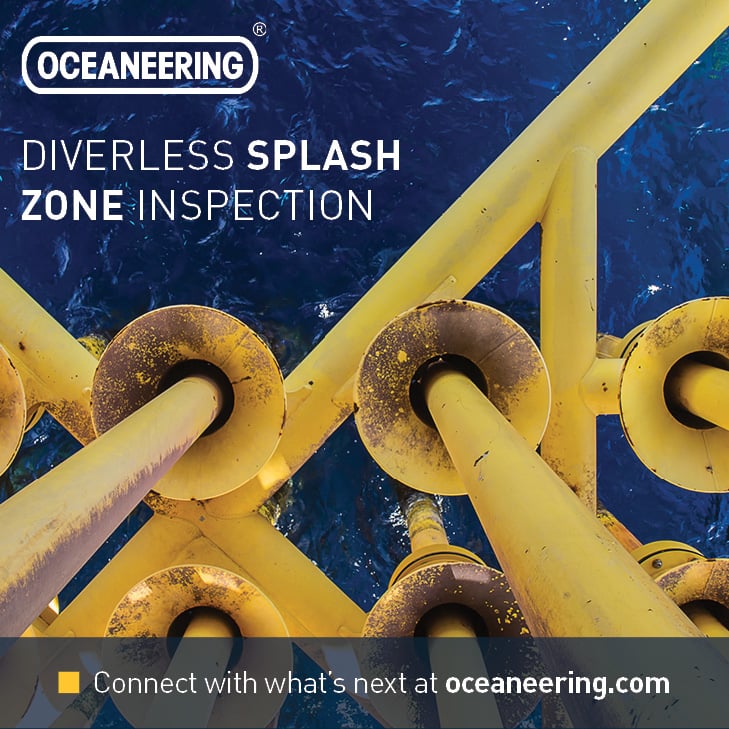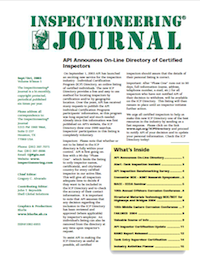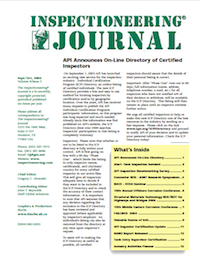99 Diseases of Pressure Equipment: Ammonia Stress Corrosion Cracking
99 Diseases of Pressure Equipment: Carbonate Cracking
99 Diseases of Pressure Equipment: Chloride Stress Corrosion Cracking
99 Diseases of Pressure Equipment: Hydrogen Assisted Cracking or Hydrogen Embrittlement
99 Diseases of Pressure Equipment: Liquid Metal Cracking
99 Diseases of Pressure Equipment: Wet H2S Cracking (HIC/SOHIC)
About Cooling Tower Inspections
Effective Planning for Utilization of Contractor API Inspectors for Turnarounds
Alert - Tank Inspection Incident
API Inspection Benchmarking Survey
API TES - Tank Entry Supervisor Certification (TES)
99 Diseases of Pressure Equipment: 885 Embrittlement
99 Diseases of Pressure Equipment: Cavitation
99 Diseases of Pressure Equipment: Graphitization
99 Diseases of Pressure Equipment: Short Term Overheating
99 Diseases of Pressure Equipment: Thermal Shock
99 Diseases of Pressure Equipment: Vibration Fatigue
More Than Low Hanging Fruit - Reaping a Greater Harvest - RBI and Step Change
In-Service Measurement of Pipeline Wall Loss Due to Pit Corrosion
Risk Based Inspection Implementation
Software and Handheld Devices Can Dramatically Improve Inspection/Service Management
99 Diseases of Pressure Equipment: Caustic Cracking
99 Diseases of Pressure Equipment: Green Rot & High Hardness Fittings
Effective Planning for Utilization of Contractor API Inspectors For Turnarounds
Introduction to the 99 Diseases of Pressure Equipment
Proposed API In-Line Inspection System Qualification Standard 1163
2003 Inspectioneering Journal Article Index
This is the name given to a form of embrittlement that occurs in 400 series of stainless steels, duplex SS's and less commonly in some 300 series stainless steels containing a metallurgical phase called ferrite. The embrittlement occurs from 600...
Ammonia stress corrosion cracking (SCC) has been around a long time. Most everyone has experienced it from time to time. It's not uncommon in brass tubes in cooling water service that is contaminated with ammonia due to biological growths or other...
Carbonate cracking (CC) of carbon steel has seen an increase recently in frequency and severity in some refinery cat crackers, especially in fractionator and gas processing overheads. Some gas scrubbing units are also susceptible. CC is a form of...
I already mentioned this common affliction in the introduction. Caustic cracking was long called caustic embrittlement, but since no embrittlement actually occurs that name is fading away.
Cavitation is the sudden formation and immediate collapse of vapor or air bubbles in a liquid stream when system pressure falls below the vapor pressure of the liquid. The sudden collapse of these tiny bubbles generates enormous, though tiny forces...
Chloride stress corrosion cracking (SCC) is about as well known as any SCC mechanism can be, so I won't dwell much on it here, but want to mention it for the sake of completeness and hopefully mention something that is not as commonly known about...
Graphitization is not something that operators can do much about, and thankfully it is not very common. We as engineers and inspectors have to know about this one and prevent it or detect it. It occurs when the microstructure of some carbon and...
Now you say, he's got to be putting me on. What is green rot? I didn't invent it. I first read about it in one of the early texts on corrosion engineering by Ughlig or Fontana, the venerable corrosion professors at MIT & Ohio State. But when I...
Hydrogen Embrittlement (HE) is an insidious form of degradation that can strike during equipment fabrication, cleaning, repairs or while in-service. It stems from the infusion of atomic hydrogen into some higher strength steels that then leads to...
Oceaneering's splash zone inspection services will help you confidently detect flaws and accurately extend asset life with our comprehensive inspection and fitness-for-service maintenance plans.
Liquid Metal Cracking (LMC) (aka "liquid metal embrittlement") is another insidious form of cracking that strikes when you least expect it. It most commonly afflicts austenitic stainless steels, but can afflict other copper, nickel and aluminum...
This failure mechanism is unfortunately all too common in our industry. It's also known as stress rupture, and it is usually entirely preventable by proper maintenance and operating procedures. It occurs when equipment, piping or furnace tubes...
Thermal shock is another one of those pressure equipment afflictions where communication with operating groups is a vital factor in prevention. Thermal shock failures usually involve sudden quenching of high temperature equipment and furnace tubes...
Few of us have not experienced or heard about vibration fatigue (cracking) failures, especially around pumps and compressors. Typically small branch connections, equalizer lines, vents and drains are susceptible, especially if they are screwed...
There are a variety of forms of wet H2S cracking. In this short article I will focus on two of the most common forms: hydrogen induced cracking and stress-oriented hydrogen induced cracking (HIC/ SOHIC). HIC is often fairly innocuous (but not...
A new recommended practice from the API is in the final stages of preparation before publications. It is API RP 577 on Welding Inspection and Metallurgy.
The following article on the art and science of cooling tower inspections is part one in a series. This first is a primer. We recommend that readers consider using this article to edit their engineering practices for cooling tower inspection...
Recently an unnecessary financial incident was caused as a result of an inadequate tank inspection and failure to recognize the hazards of rain entering leaking fixed roofs of storage tanks. A bolted bladder tank upgrade was scoped for miscellaneous...
The API Inspection Subcommittee has issued the second edition of their inspection benchmarking survey. We are encouraging as many sites, worldwide, to participate as possible, so that we have the most amount of data available for analysis and...
API is currently developing a new Certification Program - Tank Entry Supervisor Certification (TES).
In the previous articles, we have put all the Pre-Turnaround and actual Turnaround activities in place to get the job safely done. Now we need to find the API Inspectors and have them approved by the client as quickly as possible. I have indicated...
We have discussed most of the pre-turnaround planning details. We are ready for the next step. The cost for the Turnaround is normally the most important item right behind SAFETY. In many cases the salary, per diem and travel costs have been part of...
In today's chemical and refining industries, sustained long term reliability of facilities is critical to profitability and competitiveness. In fact, history shows that differences in operating expenses between best-in-class refineries, and poor...
During the past two years, a new High Resolution Gamma Ray Detector Array System to detect and measure small corrosion pits in real-time in the inservice piping in process industries, has been in development. This High Resolution Gamma Ray...
Many of the guyed flare stacks and wire rope or strand supported structures in use in U.S. and overseas refineries, pipelines and chemical plants were erected in the 1950's, 60's and 70's. Some were built even earlier. While many of the components...
Welcome to a new series of articles about the ninety-nine leading types of degradation, flaws and failure that can and do happen to pressure equipment in the hydrocarbon process industry.
"Low Hanging Fruit" and "Step Change" are analogies that have been bantered around in our industries for some time. Picking the low hanging fruit is just the beginning and something that most passersby can glean. Also, real change that affects an...
Next year, the API Inspector Recertification Program (ICP) will be recertifying inspectors who have held their API certifications for more than 6 years. Things have changed this time though, and inspectors will be required to pass a short exam...
A meeting of the API Pipeline In-Line Inspection Standards Group was held in Houston, Texas on October 17, 2002. The following is an excerpt from the Draft Scope of the Standard in the working dated, May 13, 2002.
This newly issued (28 August, 2003) document reports the results of discussions with representatives of refining firms, technologies, and services providers, research institutions, and other organizations on current and future trends in the U.S....
There are many aspects to successful, effective and efficient implementation of RBI 1, such as; - Data collection - Operations data - Mechanical data - The role of inspection histories and inspection planning - How much data do I really need to...
The large LNG facility is located on DAS Island, offshore of Abu Dhabi, in the Persian Gulf and experiences extremely high humidity year round. These conditions are known to produce a high potential for external corrosion and under insulation...
Many engineers are still performing their inspection and service activities and daily tasks using manual, paper-based forms. However, applying appropriate technology and providing simple-to-use automation tools can increase productivity, improve...
This document gives an overview about the structure and the contents of the Pressure Equipment Directive.






























